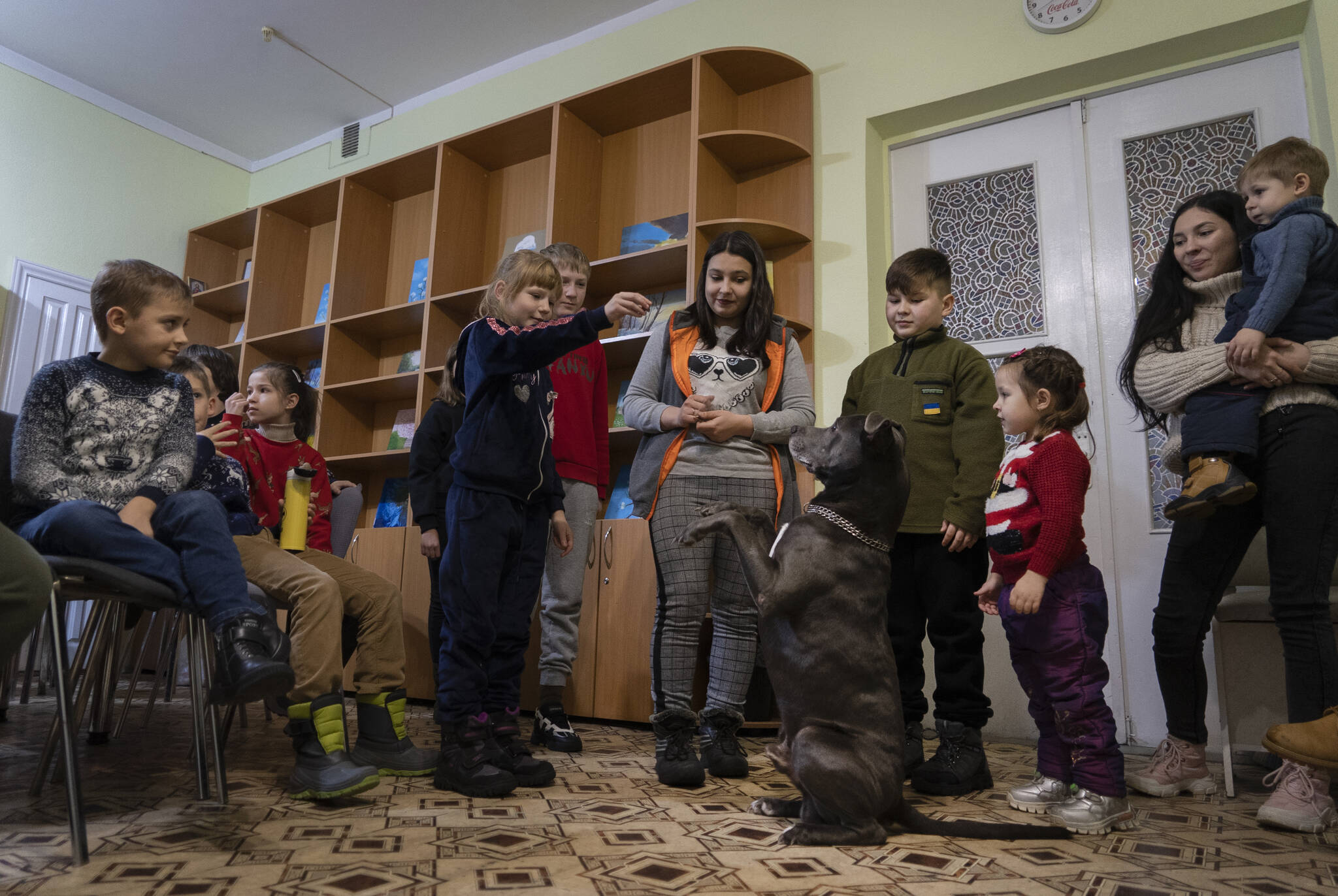BOYARKA, Ukraine — Bice is an American pit bull terrier with an important and sensitive job in Ukraine — comforting children traumatized by Russia’s war.
The playful 8-year-old gray dog arrived on time this week to a rehabilitation center on the outskirts of the Ukrainian capital, ready to start his duties.
As Bice waited in a hallway, inside of what looked like a school classroom with paintings and some books, a dozen children were seated around a table listening to Oksana Sliepova, a psychologist.
“Who has a dog?,” she asked and several hands raised at once while the space filled with shouts of “Me, me, me!”.
One youngster said his dog was named Stitch; “Tank,” said another boy, adding that he has a total of five, but he forgot all their names. Everyone burst out laughing.
The seven girls and nine boys — ranging in age from a 2-year-old boy to an 18-year-old young woman — look at first like schoolchildren enjoying class. But they have particular stories: Some witnessed how Russian soldiers invaded their hometowns and beat their relatives. Some are the sons, daughters, brothers or sisters of soldiers who are on the front lines, or were killed on them.
They come together at the Center for Social and Psychological Rehabilitation, a state-operated community center where people can get help coping with traumatic experiences after Russia’s invasion in February. Staffers provide regular psychological therapy for anyone who has been affected in any way by the war.
In the past they have worked with horses, but now they are adding support from another four-legged friend: Canine therapy.
Located in Boyarka, a suburb around 20 kilometers (12 miles) southwest of Kyiv, the center was established in 2000 as part of an effort to give psychological support to people affected, directly or indirectly, by the explosion at the nuclear plant in Chernobyl in 1986.
Now it focuses on people affected by the war. These days, when some areas are without power after the Russian attacks to Ukrainian energy infrastructure, the two-story building is one of the few places with light and heating.
With the kids gathered, some wearing festive blue or red Christmas hats, Sliepova cagily asked if they wanted to meet someone. Yes, they did, came the response. The door opened. The faces of the children glowed. They smiled.
And in came Bice, the tail-wagging therapist.
Darina Kokozei, the pooch’s owner and handler, asked the children to come one by one, to ask him to do a trick or two. He sat. He stood up on his hind legs. He extended a paw, or rolled over. Then, a group hug — followed by a few tasty treats for him.
For more than 30 minutes, Bice let everybody to touch him and hug him, without ever barking. It was as if nothing else mattered at that moment, as if there were nothing to worry about — like, say, a war ravaging their country.
This is the first time that Sliepova has worked with a dog as part of her therapies. But, she said, “I read a lot of literature that working with dogs, with four-legged rehabilitators, helps children reduce stress, increase stress resistance, and reduce anxiety.”
The kids did not seem stressed out, but of course the reality is still out there.
She observed how some children are scared of loud noises, like when someone closes a window or when they hear the sound of a jet. Some drop to the floor or start asking whether there’s a bomb shelter close.
Among the children were a brother and sister from Kupyansk, a city in the eastern region of Kharkiv, who witnessed Russian soldiers storming into their home with machine guns, grabbing their grandfather, putting a bag on his head and beating him, Sliepova said.
“Each child is psychologically traumatized in different ways,” she said.
The moms of some of the kids remained almost all the time seated along one of the walls, watching and listening at distance. When Bice came, some took pictures of their children.
Lesya Kucherenko was here with her 9-year-old son, Maxim. She said she can’t stop thinking about the war and what could happen to her oldest son, a 19-year-old paratrooper fighting in the town of Bakhmut in the the eastern Donetsk region — one of the most active fronts these days.
Maxim smiled as he plays with Bice, but he was always checking on his mom and turned his head around to see her every once in a while.
Kucherenko said sometimes she breaks into tears when thinking about her soldier son. Right before this session, she got a call from him. He told her that he was fine, and by just remembering that, she started crying. The next second, Maxim was there, asking why.
“You see? He’s comforting me — not me him,” she said.
As for the comforting canine, what’s the best message that Bice offers the kids?
Owner Kokozei needs to think for only a couple of seconds, and replies: “Freedom.”
“Freedom from problems, and happiness,” she adds.

